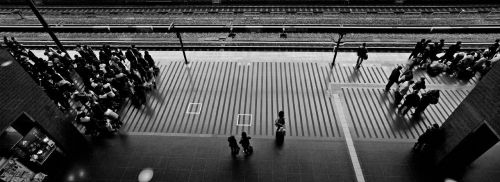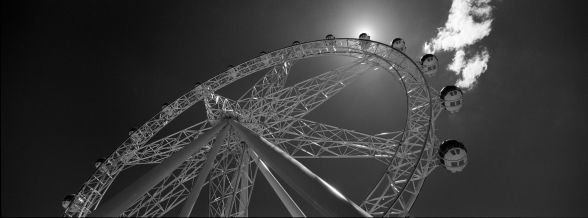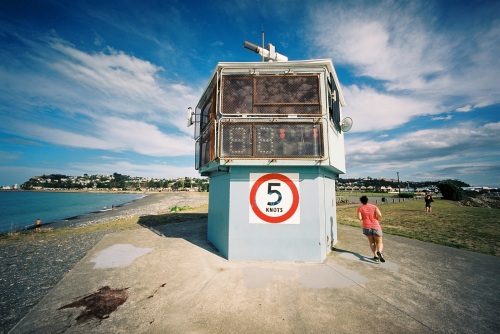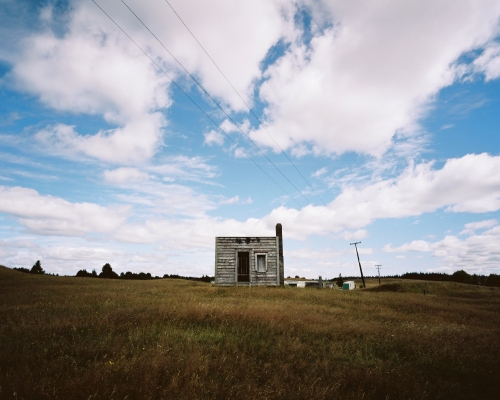Matt is an accomplished wide angle photographer, using some pretty special gear. Here is what I learnt by spending an hour with him at the Spread Eagle Hotel in Richmond whilst his partner attended her weekly “Richmond Knitters” stitch and bitch at the same pub…
How did you get into photography?
It was an accident, a complete accident. I did photography in high school, hated it. Hated it so much! I enjoyed the science behind it, but they didn’t really teach us anything about taking photos. It was all about the process. Not looking at other photographers and that sort of stuff. All about loading the film, loading the camera, developing the film, and printing. All the nuts and bolts around process. It was just enough to get you started but not enough to really excite anyone.
So there was nothing on composition?
Absolutely nothing. It was crap. The photography teacher was an “artist”. She didn’t really like the idea of “teaching” art, I think? She would teach the fundamentals; how to put the paint on the canvas, but she didn’t like the idea of forcing or influencing us into a particular style or genre.
MSP – How disappointing. The teacher not wanting to influence the students and stifle their particular creative direction is admirable, but without understanding how to hammer a nail or cut a piece of wood a carpenter cannot make a masterpiece. A photographer cannot break the rules of composition until they understand them.
There is nothing more rewarding than showing someone with a shiny new interest in photography to go with their kit DSLR the rule of thirds and how to use leading lines in a photograph… It gets them excited about learning more and can lead to a lifetime interest.
What would you do differently in the same position?
I would just give them books, and encourage them to look at a lot of photos. You can learn everything you need to know just by looking at photos. I work in a photolab, and I learn from other peoples mistakes. I see something and think “well, that could be better this way or that way”, and that happens a thousand times a day!
MSP – An approach I have come to love. Deconstructing the work of the masters to understand how they have achieved their results is a worthy pastime of mine. You can read about my adventures in reading photobooks throughout the blog in the “technique” section.
I started working for a Japanese tourism – wedding company. People coming over to Australia from Japan to get married. It was just like any other “add on” package from a travel agent, except this one was a wedding ceremony on the Gold Coast. Go to Dream World, go to Sea World, go to Movie World, then go and get married! I used to be the video guy, doing all the video related stuff. Things had just changed from hi-8 to mini dv.
One day I was going to go up to the hinterlands and video some nice waterfalls or some crap. When I went to the gear room, there were no video cameras available at work. My boss saw me going through the gear and said “just take a still kit”. I took an EOS500, 28 – 80mm, 75 – 30mm, a couple of rolls of Fuji Reala, and a polarising filter for good luck.
Borrowed the kit, took my photos of the random waterfall, and that was it! That was where I “caught it”. The next day, the films went to K-Mart to get printed – $12 for two rolls complete with prints! I still have the photos – they aren’t too bad. I took a photo of the moon during the day and the lab at K-Mart tried to make it look like night… The 6×4 glossy prints got me hooked.
What was the first camera you bought after this experience?
With my own money? A Canon EOS50 not the “e”, the one with the eye control. Then I thought, like most photographers, I am going to buy one lens, and if I get a decent one I will never have to buy another one ever again. The “forever” lens was a Tamrom 28 – 200mm. It’s still going. Famous last words those… “never buy another lens…”.
Tell me about film.
I have stuck with film because with the Xpan there is no digital alternative.
MSP – Check out Matt’s very well visited blog here and his specialty pages about Xpans here.
But couldn’t you just get a super wide for a 35mm digital?
Yeah, I know it will get wide but cropping a 35mm image into panoramic format is just not the same. When I can see through the viewfinder what I am going to get, or close to it, I feel better about it. It feels more normal.
MSP – The panoramic format Matt talks about is a challenge worth having a crack at for any photographer. You can find out more about it here.
Working in the industry I get developing, scanning and printing for next to nothing, so I have that advantage. I don’t hate on digital. Film is just for me.
But why do you feel like film “just for you”, Matt? We need to know more…
The “why” is so difficult. Film and digital are not two different things. It’s the same thing, it’s just how you use it. I approach photography differently between the two mediums. I am not using much digital at the moment apart from my phone.
A photo is a photo, but I approach taking one differently when using film. I behave differently. With digital you can just click away, it doesn’t matter what you are doing. If you want a black and white shot, you can change it in photoshop – I suppose I just feel lazy. For me, digital takes something away from the process – things like playing with levels, adding a filter, and desaturating in digital just doesn’t appeal to me as much. With film, what you shoot is what you get.
When I use film, I know the light hit the film at a particular point in time. It went through the lens, it is captured on the film, I scan it. Very rarely do I do any additional post processing to my film photos. With digital, I am constantly thinking “oh, I can crop it like that, or do this…”
MSP – Matt’s purist approach to film is quite inspiring. For many of us who still stick with film, the theme of being more conscious and deliberate in taking each shot is common. To find out what I love about film, check this out.
I suppose there is also a bit of the eternal tension between craft and technology at play. Film just feels more crafty whereas digital (which I also love) is more megapixelly…
Hmmm, thinking more about it, a long time ago, a photography tutor I had at some night courses I did – Tony – said each person in the class had to do an assignment. Mine was “you are tradition’s servant, cursed”…
MSP – At this point Amber (Matt’s partner) interrupted the interview… talking about what she was going to order for dinner. For the record, I ordered the Eye Fillet from the Spread Eagle in Richmond and it was delicious!
MSP – It took me a while to understand the brief – until Matt explained further.
You are a servant of a tradition, but cursed at the same time. Someone who is serving a tradition but cursed by it.
I never did the assignment – it sounded like a lot of bullshit at the time. As years went on, my perspective changed, and the words kept coming back to me. I realised the curse applied to me. There is my love of tradition in film. I am it’s servant, and I cannot leave it behind – the underlying theme of everything we have been talking about, I suppose.
Tell me about Wide Angle composition, which you are quite well known for… For you, wide angle has been a consistent theme. Everybody remembers “their first time”.
The first shot I really felt I nailed was one called Akaroa Harbour on my Canon EOS 50 with a 24mm Lens, with Agfa Ultra 50, my favourite film! It’s kinda when I got into the panorama thing. The guy I worked with grabbed my film and shoved it through the printer, not knowing it was mine. He had the machine in panorama mode. When these big, long prints came out of the machine, I looked at them.
They were mostly forgettable pictures of a car I had just bought, but then this one came out of the harbour. It was cropped, but on this beautiful wide piece of paper it just looked wonderful.
After that, I was getting conflicting information from different photographers on wide angle photography. Some said “approach your subject” prior to taking the shot – whether it was street or something else. Get in there and interact with the subject.
There is a scientific theory another said that just by observing something, it changes at a molecular level – but that did sound like some BS to me. Like wrapping something in a shiny new box makes it seem different. He used to say “approach the subject”.
Another photographer said “get closer”. So I would be thinking – approach the subject, get closer – then I ended up right in there, and I can only achieve that with a really wide angle lens.
I have also been in situations when I have wanted to take photos of things, but couldn’t because there wasn’t enough “space” or an obstacle like a main road to my shot which I can only fix by shooting wide.
What was the progression of your gear acquisition?
I started with a 24mm first – and you are going to think I am nuts here – I thought that was too wide, so I went back to 35mm!
One day, working at a camera shop, we had a Voigtlander rangefinder and a 15mm lens second hand set on the shelf. I had never really thought twice about it, but one of my colleagues, Bob, borrowed it for a day.
When he brought back his films, I developed them for him. I saw them and thought “oh my god!”. I have to have this camera! So, I borrowed it, and that was that. I soon owned it. I still have one of my Voigtlanders left on the shelf at home.
I was hooked on super and ultra wides. Then I got the 30mm and Xpan. I bought the Xpan online from a guy who wanted to buy a motorbike. (I wonder if he still wishes he had the Xpan!)
The Xpan body I bought online. I had it sent to work, so the thing didn’t end up on the doorstep for half a day. Hasselblad love boxes… The Xpan was within a box, within a box, within yet another box! The exterior boxes are grey and nice, and then everything else has it’s own little box. Then a sleeve pulls all of these together.
MSP – People think Apple were the first ones to create beautiful packaging for consumer electronics goods! Leica and Hasselblad understood this many years ago…
The 30mm was bought later, separately. I was already familiar with the lens. A prominent New Zealand photographer already had the 30mm, and I was familiar with his work. He came into the shop with the 30mm one day, when I already had Xpan body. I asked him for a look through the viewfinder, and I was gone at that point.
What are you top tips for someone wanting to develop their wide angle images? And don’t tell me to get closer…
“But that’s #1!!!!”
You gotta get the whole thing in. If you are going to take a photo of something, get right in there. Show some context. Show the surroundings. Nobody wants to see a photo of a rubbish bin, they want to see the context of it. Is it on a road, are there people around it, what’s the sky doing?
MSP – When I first tried it, I always thought wide angle was about getting further away and getting more into the scene. You can read more about my own wide angle journey here.
I think shooting wide is like being greedy. You are getting more in, whether or not it adds more value depends on the composition.
Get closer.
Bring more context – what is happening around the subject.
The third is to master the concept of hyperfocal distance. Don’t worry about focusing, just hyperfocus your lens by setting your infinity marker to your aperture, and just shoot it. Don’t worry about the technical stuff. The camera will take care of all that. Obviously, I am making it sound a bit easy – you still need to know your aperture and shutter speed.
What’s you favourite film and developer?
I’m not that guy.
I shoot, mostly to the disgust of other film lovers, Kodak BWCN. It uses the C41 developing process – so I don’t have to worry about it. BWCN gives consistent results – I know what I am going to get. I used to be obsessed by Agfa Scala, a black and white transperancy film. I used to love that stuff! You can’t beat looking at transparencies on a lightbox. Can’t beat it. There is just less and less of it being manufactured.
Do you worry about the future of film?
When it comes to black and white negative film, there is no reason why it should ever stop being in production.
Cameras are a different story. A few years back, Nikon were convinced they could make a new version of the Nikon F. Someone had looked at the factory line and convinced them that they could get them back into production with minimal changes. So they tried, and launched the new film camera, but they lost a lot of money!
What first steps should someone take when getting into Wide Angle without breaking the budget?
Whatever system you have already got will be fine. Just check out the range of lenses by checking images taken with various focal lengths on your system on Flickr and other places to see what other people are doing with similar gear.
For 35mm photographers, a 21mm focal length lens is a great place to start. It’s affordable. A 24mm is also probably going to do the job. Get one and see if you like it by dipping your toes in the water. Some people decide they are not into it, but yeah, see what happens.
MSP – I am still not sure if I love wide angle or not!
Favourite Camera and Lens setup? XPan with 30mm lens?
Yeah, that’s my favourite.
And you also have a Mamiya 7 with a 43mm Lens?
Still shooting it. It’s nice to have a foreground in the image vs the Xpan! The 6 x 7 format means I am not missing that top and bottom third of the frame. It is a different way to shoot, but at the same time similar to shooting with the XPan.
What’s the one image you would like to be remembered for? What about the one I have reviewed previously?
Matt turns the tables – “What do you like it about it, Damian?”
MSP – I like the idea of being more conscious of what is around you. By simply changing the perspective from which you viewed the scene you created a wonderful image. Actively seeing the world in front of you from a different angle.
So, what is the favourite image you have taken, Matt? Pick one that represents your photography.
My favourite…. One I took in Japan – Kyoto train station. People waiting at the station platform, and I am diagonally above them. The tracks are empty and there is people standing waiting to get on the train, but they are waiting where they know the doors are going to be.
The people are all in distinct groups, waiting for the train to arrive and the doors to open. There are nice lines throughout the image, the train tracks, the powerlines, the pattern of the tiles on the platform, and the orderly positioning of the people.
In the middle of all this predictability are two or three people who don’t know where the fuck they are or what they are supposed to be doing. Order and chaos contrast in the image. I shot it on the Xpan with the 30mm.
For someone getting into wide angle film photography, what gear would you recommend?
If you have some money to spend, try a Voigtlander Bessa L, and a 15mm or 21mm Voigtlander lens to match. The viewfinder is external, but if you understand hyperfocal distance, you can jump right in there and just start shooting! Only issue is that you will probably catch the rangefinder bug whilst you are at it!
MSP – More about rangefinders here.
Rangefinders are much smaller and quieter than an SLR. Not many people out there know what they are. Those that do get it, give you a knowing look when you are out and about. You can point them at most people without them minding too much.
The quietness combined with shooting ultrawide and close means people have no idea when they are in frame. They think “oh, he must be way too close and off to the left for me to be in the photo.” I will pretend to be looking around a bit and pointing in various directions, focusing on something else, then just casually lower it down and “click”.
I had never used a rangefinder until I got the Xpan. It all seemed like a lot of mucking around, manually focusing etc. I thought the format weighed outweighed the “cons” of a rangefinder for me. The panoramic format was just too tempting.
I was a bit intimidated by the rangefinder – I just decided I would keep using it until I had learned to like it. When I got the Xpan, I probably didn’t “deserve” it as a photographer. I sorta grew into it. It was a massive investment for a young man. I was 24 at the time. My biggest investments have been firstly my car, then my camera!
I think I grew into the camera.
I was thinking about the questions you sent through this morning to prepare for the interview. I don’t think my photos look “wide”. I don’t feel that way. I look at other people’s photos and I can often tell straight away they were taken on a wide angle. If your photo doesn’t look like a “wide angle” then you have done something right. A little bit like HDR – if it is noticeable, then you might have used it a little too much!
If you can shoot it, and it doesn’t look wide, then you are on the right track.
MSP – Thanks for your time today Matthew.
Conclusions.
Lessons from Matt
- Get closer.
- Surround your subject in context to give more meaning. Show the subject in the environment it exists in.
- Avoid making images noticeably “wide” in composition.
Options for Starting in Wide Angle
- Check out other people’s work on Flickr by searching on lenses that are available for your system.
- Buy a 21mm or 24mm lens for your existing system
Next Steps
- Buy a Bessa L and 15mm lens. Learn to love film.
- Get a job as a QC lawyer / Surgeon / CEO and buy an Xpan and 30mm lens.
Matt is not a “one trick pony” – he is an accomplished artist photographer. However, there is massive benefits to finding a style or genre that you love and pursuing a more narrow but infinitely deep creative path.
The more time you spend with a clear focus, the more nuanced and detailed your skills can become. Try all kinds of photography, but occasionally spend an extended period of time on a particular style, genre, or gear and develop expertise. It could be a combination of subject type and lens. For a few months, all I did was street photography using a 135mm focal length lens and film. The more time I spent with this unusual focal length, the more I understood how to use it for the best result.

 March 14, 2015
March 14, 2015 






Great post. Love the photo and the interview.
>> Try all kinds of photography, but occasionally spend an extended period of time on a particular style, genre, or gear and develop expertise.
I certainly will give it a try. Thank you very much!
LikeLike
Hey Helen, must be just about time to do an interview with you?
Interested?
LikeLike
I promise to be nice!
LikeLike
My face turned red. I know you are nice, but you don’t know what you are asking for. 😉 I am really a beginner, who just yesterday decided to try manual setting for a while so she could get a real feel about ISO, and shutter speed (she is still struggling with the noise.) I enjoy learning and I’ve found out that your writing style is easier for me to learn so I am a big fan 😉 Anyway, give me one or two years… I would love to when I become qualified.
There are a couple of photographers I would like to know more. Maybe Randall at China Sojourns Photography? (I offer free suggestions though.)
Thank you! Even thought your invitation made me nervous, I do appreciate your recognition of your big fan. 😉
LikeLike
I was thinking about asking you about how you have been developing and the things that matter most – but I understand you might not be 100% into the attention!
LikeLiked by 1 person